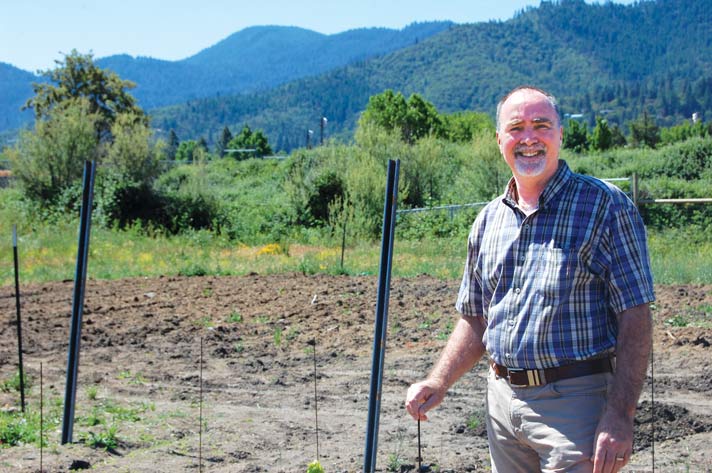Article from the Summer 2015 issue of Southern Oregon Wine Scene Magazine
The glass of wine you’re drinking right now was influenced by many factors…from the grower to the wine maker to arguably the most important aspect of terroir…CLIMATE!
Having a conversation with viticultural climatologist Greg Jones is much like drinking a glass of premium wine. With his bright intensity, Jones could be compared to a fine vintage himself and after imbibing his fruit-driven wisdom, I invariably come away feeling smarter and better looking.
For our latest discussion, I found Professor Jones in his office on the Southern Oregon University campus where he is Director of the Division of Business, Communication and the Environment and professor and research climatologist in the Environmental Science and Policy Program. Though his official titles cover diverse areas of study, they all come together in a glass of Southern Oregon wine. How so? Winemaking is an agricultural enterprise, starting with the selection of a vineyard site and culminating in the production of grapes, but it is also the art and science of fermenting the juice and making decisions as to aging and blending to create the best expression of a particular varietal. A third component is marketing the finished product, essentially competing with a world-wide wine selection that can be found at almost any supermarket. This daunting enterprise requires the skills of farmer and chemist, a finely-tuned palate and plenty of business savvy.
It is with good reason that Jones is considered one of the most authoritative people in the wine world, one whose opinion is indispensable when it comes to deciding what variety of wine grape to plant where. Beginning with his doctoral thesis on the climatology of viticulture in Bordeaux, France, he has collected data on climate, hydrology, soils, weather and growing techniques in vineyards all over the world, helping to describe and define viticultural areas and assess best practices based on the quality of wines produced. His studies have also focused on climate change and sustainability in grape production, two increasingly hot topics in the wine world today. His contributions have earned him numerous accolades. He made Decanter magazine’s 2009 Power List of the fifty most influential people in the wine world and was named Oregon Wine Press 2009 Wine Person of the Year. In 2012 and 2013 intowine.com listed Jones among the hundred most influential people in the US wine industry.
In our region, with its emphasis on Pinot Noir, Jones is often called upon to evaluate sites for possible propagation of this cool weather varietal. Wait a minute. Did I say Pinot Noir is big in Southern Oregon? Yes, I did. Although this varietal has been famously identified with the northern reaches of our state, the Willamette Valley in particular, it has been the predominant wine grape produced in Southern Oregon for some years. The 2008 Oregon Vineyard and Winery Report compiled by the Oregon Field Office of the USDA, shows that in the Rogue Valley American Viticultural Area (AVA), consisting of Jackson and Josephine Counties, the greatest tonnage of a single varietal harvested was 622 tons of Pinot Noir, with Pinot Gris a distant second at 445 tons. The 2013 report compiled by the Southern Oregon University Research Center (SOURCE) puts Pinot Noir tonnage harvested in the Rogue Valley AVA at 1,788 tons, nearly a three-fold increase in five years. Pinot Gris again came in second at 1,029 tons.
When you consider that wine grapes are typically produced where the growing season temperatures average between 53 and 71 degrees Fahrenheit and that Pinot Noir occupies an even narrower temperature band, 57.2 to 60.8 degrees, the fact that Oregon’s most southerly AVA is a Pinot Noir growing area is indeed surprising. When I ask how this is possible, bearing in mind toasty Rogue Valley summers, Jones explains that at sites suitable for Pinot Noir, temperatures are moderated by aspect and elevation. Slopes that receive primarily morning light are cooler than those with western exposure. Think of it as being similar to your house, he says. You wouldn’t grow the same plants on the shady side as you would on the sunny side. With its northeast-facing slopes, DANCIN Vineyards, just outside Jacksonville, is a good example of the cooling effect of aspect. Higher vineyard elevations in the southeastern part of the Rogue Valley AVA also result in cooler temperatures. A good example of a higher site that produces excellent Pinot Noir is Irvine Family Vineyards in Ashland’s Bear Creek Drainage, where vines thrive on east-facing slopes at 2,100 feet. What makes our Southern Oregon wine region so special is that growing sites run the temperature gamut from those favoring the cool varietals to the warmer conditions that make for Red Lily’s lucious Tempranillo and Quady North’s big Syrah.
Jones hastens to add that Pinot Noir from Southern Oregon is typically a little more ripe, producing vintages with darker berry and plum notes on the palate, as compared to the lighter, more bright fruit Willamette flavors. It’s little wonder that much of the Pinot Noir produced in Southern Oregon makes its way up north for blending purposes, especially in years when ripening in the northern AVA’s has been problematic.
We also talked about cultivation practices that can protect grapes from excessive heat. In warmer vineyard blocks, canopies may be left leafier rather than being pruned to a narrow, straight up and down profile. This affords the fruit more shade and coolness. Row orientation and trellising strategies can be used for heat management as can application of kaolinite and bentonite. Jones asks if I have ever noticed the local pear orchards, how the leaves sometimes look white. In response to my blank look, he explains that whitish appearance is the result of treating the trees with kaolinite. When sprayed on the leaves, the powdered mineral reflects heat to cool the tree the way a white roof cools your house. Bentonite is a clay that attracts water. When applied around plant roots it helps retain moisture. Such practices will become increasingly important aspects of vineyard management given the continued impact of climate change.
And what about climate change? Jones is among those scientists who contend that although changes in climate have occurred throughout history, climate changes noted in recent times appear to be more rapid and of greater magnitude than in the past. What does this portend for the Southern Oregon wine industry? Undoubtedly there will be more challenges. Fortunately, in Greg Jones we have one of the world’s foremost experts on the subject to help our growers face them.

 Retired Naval Officer MJ Daspit moved from San Diego, CA with husband Gary Greksouk to Ashland in 2004, where she began a second career as a writer. Daspit’s published works include the pictorial history ROGUE VALLEY WINE, co-authored with winemaker Eric Weisinger (Arcadia Publishing, 2011) and a historical novel, LUCY LIED (Fireship Press, 2014).
Retired Naval Officer MJ Daspit moved from San Diego, CA with husband Gary Greksouk to Ashland in 2004, where she began a second career as a writer. Daspit’s published works include the pictorial history ROGUE VALLEY WINE, co-authored with winemaker Eric Weisinger (Arcadia Publishing, 2011) and a historical novel, LUCY LIED (Fireship Press, 2014).